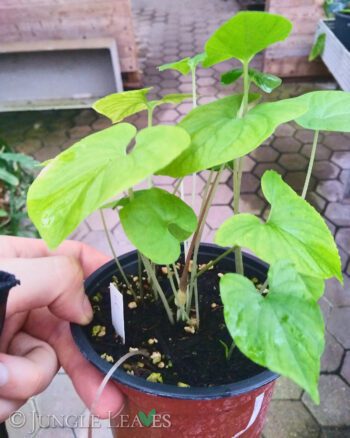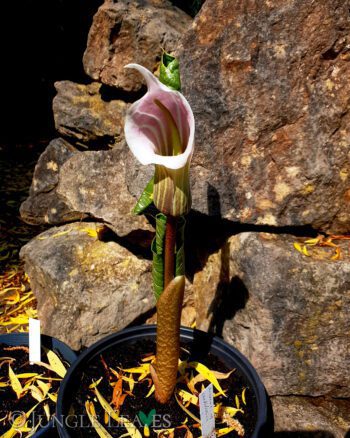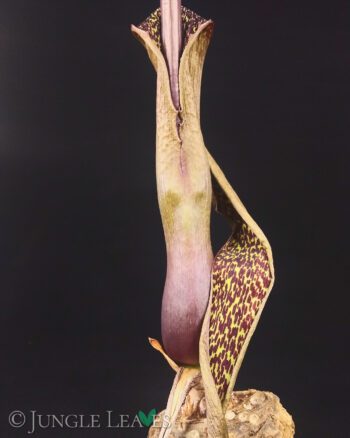Alocasia sinuata
29,99€ incl. VAT
Small species from the Philippines with highly textured and beautifully patterned leaves. Looks like an artificial plant, but is definitely real.
- Description
- Care
- Additional information
Description
Description
This species originates (probably) from the Philippine islands of Leyte, Mindanao and Palawan. Its exact origin is unknown. It is widespread in cultivation but no botanical material exists of it directly from nature. Before its description (and still partly today) it was known as Alocasia ‘Quilted Dreams’.
It is a rather smaller Alocasia and grows to about 35cm tall. The leaves grow to a maximum of 27cm long (usually closer to 20cm) and only 10 to 15cm wide. They are rather narrow. The leaf veins are sunken and the lamina of the leaf bulges out between the veins, giving them a three-dimensional structure. The leaves are very hard and waxy. Between the veins the leaves are light green, the leaf veins themselves are very dark green to black which gives the leaf an additional depth effect. An extremely cool effect that is difficult to convey in pictures.
The undersides of the leaves and petioles are light green.
You will receive a vigorous plant, approx. 20 to 25cm high in a 9cm square pot or 10cm round pot.
Care
35 cm
30 cm
Partial shade
20 – 30 °C
60 – 90 %
This plant grows in the understory of rainforests.
Real tropical rainforest has pretty little to do with what most people imagine when they hear “jungle.” One thinks of impenetrable undergrowth, constant moisture, and that there is everything in abundance for plants. Unfortunately, these misconceptions often lead to many of these rainforest inhabitants being cared for incorrectly. In reality, the undergrowth is mostly is not particularly dense, the soil is very poor in nutrients and loamy and sometimes it is quite dry for a long time!
To avoid such mistakes, here are our detailed care instructions for this plant:
Location/light: The plant likes partial shade. A place on a west or east window or slightly away from a south window is well suited for it. It should not be left in direct sunlight for long periods, especially in summer. In winter, however, it can be placed directly on a south or west-facing window and kept in a sunny spot all day long.
Additional lighting to help this plant survive the dark winter months is a great help. Otherwise it usually loses many or all of its leaves in winter and goes into a dormant phase.
Temperature/Humidity: This plant comes from a tropical climate and naturally grows best in tropical temperatures and humidity.
However, it also handles the typical conditions in a home well. It should not be below 20° C at night and at least 22° C during the day. It should not be exposed to temperatures over 28° C for prolonged periods of time. We recommend a heating mat for growing young plants or caring for them over the winter.
The relative humidity should be 60% or higher.
Water/Fertilizer: This plant likes it less wet than one would assume for a rainforest species. The substrate should never dry out completely, but it should definitely not be really wet for a long time, this can damage the roots! So better to water a little less, and in between let at least the surface dry.
If it is kept as a houseplant (especially on the windowsill), it should be watered little in winter, as the combination of colder temperatures and moisture weakens it and can lead to rotting.
Fertilizing should be done during the main growing season, from about May to September. If you do not provide additional lighting, this plant will grow little to not at all from October to April, and does not need to be fertilized. There is no need to use a special fertilizer. A normal complete fertiliser (N-P-K + trace elements) for houseplants is sufficient. Liquid fertilisers, fertiliser sticks or similar are all suitable. We recommend halving the dosage specified by the manufacturer.
Substrate/pot: In the wild, this plant grows in a very nutrient-poor soil. In the rainforest there is little or no humus as we know it from temperate forests. A thin, only 1 to 3 cm thick layer of leaves/detritus is usually directly followed by dense clay soil or stone. The roots of the plants creep along the surface under the thin layer of leaves and almost never go deeper than a few centimetres into the clay soil.
This plant should therefore be potted in a loose, acidic (pH below 7) and very air-permeable mix. We recommend our coco coir chips for these plants, which combine precisely these properties.
It also grows well in a purely mineral substrate, but we do not recommend repotting it immediately after arrival as this can cause it a lot of stress. Most of our plants are already potted in the substrates we recommend and can remain in them.
The pot for this plant does not need to be particularly large. If the pot is too large, the substrate will be dry at the top but still wet at the bottom. Then you think you have to water again and drown the plant, which in reality is still moist enough. Some experimentation is required for the right pot size. As a guide, if you can water about every 5 to 10 days, and the substrate is almost completely dry in between, the size is well chosen.
Additional information
Additional information
| Weight | 0,4 kg |
|---|---|
| Dimensions | 14 × 14 × 30 cm |
| Will be shipped as | potted plant |
| pot size | 9cm square pot |













